
John Persoon of Ultra Grow Ltd. has experienced a lot of industry
changes over the past 30 years, but there is one thing that has
remained constant throughout his career – a passion for plants.
“The bottom line has remained the same,” says Persoon
John Persoon of Ultra Grow Ltd. has experienced a lot of industry changes over the past 30 years, but there is one thing that has remained constant throughout his career – a passion for plants.
“The bottom line has remained the same,” says Persoon. “You have to get enjoyment and satisfaction out of your work besides monetary rewards, because there will be years when those rewards just aren’t there.”
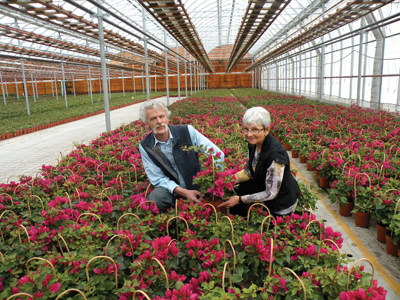 |
|
| Company owner John Persoon and office manager Sheila Leyton. Advertisement
|
Ultra Grow, a leading potted plant producer in the Niagara region of Ontario, has been a market-driven company since it was launched in 1988. It began with a focus on azaleas as the principal crop, but has since evolved into one of Canada’s largest bougainvillea growers.
There are several minor crops also on the go throughout the year as John and office manager Sheila Leyton, who’s been with the company since July of 1989, seek out new market opportunities, and with good success.
GROWING UP IN A GREENHOUSE FAMILY IN THE NETHERLANDS
Persoon grew up in a greenhouse family in the Netherlands before emigrating in 1976. He first worked for growers in Waterloo and Fenwick, Ontario, before setting out on his own.
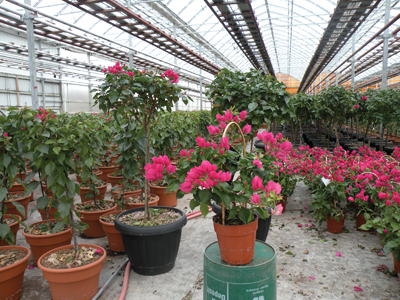 |
|
| A small sampling of Ultra Grow’s product lineup.
|
Ultra Grow is located atop the Niagara Escarpment in Grimsby, and along a major access road to the Queen Elizabeth Highway, which is only five kilometres away. What attracted Persoon to this site? For starters, the road was on a natural gas line. It also had three-phase power, which wasn’t common at the time. The site was especially flat and ideal for greenhouse construction, and at 10 acres, it offered plenty of room to grow.
Grimsby is well situated for a greenhouse operation as it is centrally located within the Niagara industry and only minutes away from a full range of suppliers and expertise. The QEW offers easy access to the Toronto or U.S. markets.
Ultra Grow began with 35,000 square feet of space and was one of the first greenhouses in the province to install environmental computers.
LEADING EDGE TECHNOLOGIES HAVE LONG BEEN INCORPORATED
The greenhouses are 14 feet tall, and were the tallest in the peninsula when first constructed. They’re all glass, as the crops need all the light they can get, and there are energy curtains throughout.
“We were quite up to date from very early on,” says Persoon.
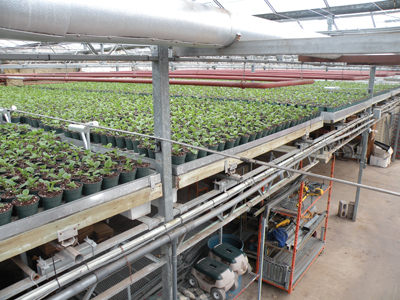 |
|
| Getting the most out of your space: thanks to 14-foot-tall greenhouses, Ultra Grow is able to start its gerbera plants over its warehouse.
|
Over the years, they switched from benches to concrete floors. “I prefer ebb and flood floors,” Persoon explains. “We’ve always had long-term crops, and tables are great if you have to work the crop all the time. But our crops don’t require that same constant handling over long periods of time.”
The floor heat helps keep roots warm and more active – and drier – between waterings.
Ultra Grow has grown to 135,000 square feet, following expansions of 50,000 square feet in 2002, and 25,000 square feet in both 1997 and 1999. In peak season, the company employs 16 people.
Azalea was a good crop for many years, and customer demand was steady.
However, the company saw an exciting new opportunity and began growing bougainvilleas on a small scale in 2005. Persoon spent considerable time talking with growers in Europe and North America to fine-tune his program. “It wasn’t until last year that we began growing them in large volumes.”
THEIR PEAK SALES SEASON PARALLELS BEDDING PLANTS
This year, some 100,000 bougainvillea plants in various sizes will be grown, about half in 6-1/2” pots. The peak sales season pretty much parallels bedding plants, with the majority of the crop shipped from mid-April to mid-June.
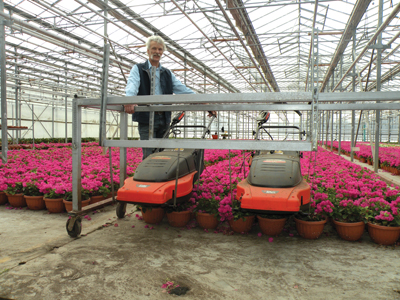 |
|
| Lawnmowers, with a little adaptation, make great plant trimmers, says Persoon. (And going electric is much quieter than his previous gas units.)
|
“It’s still mostly purple that sells,” says Persoon, noting the colour represents about 80 to 90 per cent of sales.
They also produce 8,000 bougainvillea trees each spring, which will grow to about four feet tall with a crown about two feet wide.
In their efforts to find new markets, last year they trialled some as Christmas plants, and with encouraging sales results.
Repeat business is a given in the bougainvillea market segment, as consumers who buy them for patio and balcony planters are quite satisfied. The flowering is amazing and brilliant.
OTHER MARKETS HAVE SHOWN BOUGAINVILLEA’S POTENTIAL AS A HOUSEPLANT
But the plant needs more PR, especially if inroads are to be made in making it an indoor plant. Other markets have long used bougainvillea as houseplants.
“It has been grown as an indoor plant in Europe for the past 50 years,” notes Persoon. “Consumers should be made aware of this.”
It’s a plant that needs a lot of sunlight, and it should not be overwatered. “I recommend they dry out between waterings. If they’re wet for too long, they won’t flower. You’ll get lots of foliage but not many flowers.”
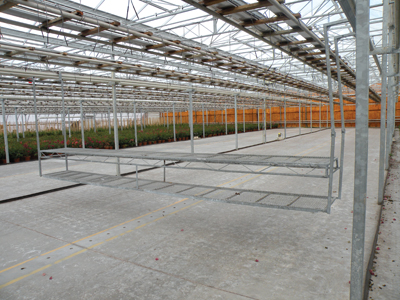 |
|
| Persoon assembled his own trolley system.
|
Keeping them too wet also fosters root diseases, such as phytophthora. “They definitely like it sunny and dry,” explains Persoon. “They can bloom year-round in the right conditions, but to get them to flower takes a lot of attention.”
The plants won’t overwinter in Canada, so they must be brought into the house.
Ultra Grow includes an information tag with each plant, and the company’s new website, www.ultragrow.net, will also include consumer tips.
The plants will go dormant in the greenhouse over the winter, giving Ultra Grow a break on heating bills. However, as part of the learning curve, a greenhouse was kept too cool one winter and that led to phytophthora problems in part of the crop. “It was way too cool, but once we turned the heat up, they recovered nicely. It’s something we don’t want to go through again. Now we keep them a little warmer.”
APHIDS THE BIGGEST PEST THREAT EACH YEAR
It has the usual pest pressures. Aphids are the most common threat, but it can also attract thrips, whitefly and mealybug. “But it’s much less susceptible to pest problems than potted mums or gerbera.”
Ultra Grow is “big on biologicals,” says Persoon. “We’ve been working with them for about five years and it’s been quite successful. The key is to put out the right product at the right time, and you can only do that if you know exactly what’s in the crop. This requires constant crop monitoring and assessing what you should use. It’s also important to anticipate problem periods, so you know when and what to expect.”
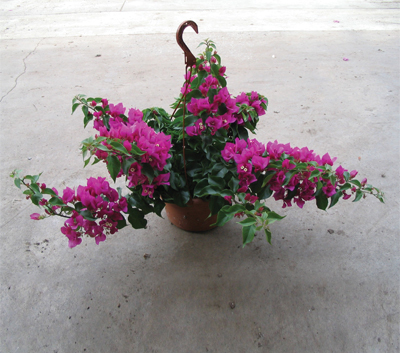 |
|
| Bougainvillea in a hanging 10” basket.
|
Regular fertilizers and soils are used, “but we sometimes add extra iron to help keep the leaves dark green.”
Bougainvillea doesn’t travel well; it’s difficult to ship long distances without affecting quality. “This helps us in marketing it as a local product that we can ship throughout Ontario.”
To maximize space, overhead tables are placed over the warehouse and workshop areas – another benefit of having tall greenhouses, in addition to uniform environmental conditions – to start gerbera plants each year. Once the plants are established, the tables are lowered by forklift to the floor. About 100,000 are grown between March and August. “It has become a commodity crop,” he says. “The prices are too low.”
Overall, the industry has experienced a number of significant changes over the years, says Persoon. “The demands on growers are higher today than they were years ago. The consumer wants better quality, but they also want it as cheap as possible. With more competition in the market, you have to provide both.”
MORE ENERGY OPTIONS FOR TODAY’S GROWERS
There are now more energy options, with some growers considering solar and wind opportunities. “In Europe, they’re hoping to develop a zero-energy greenhouse,” says Persoon. “It’s going to come, and it will be necessary.”
There’s definitely a movement to grow in the most environmentally friendly fashion, adds Leyton. “We’ve been seeing this develop over the past 10 years.”
The rise in the Canadian dollar has caused them to focus more attention on the domestic market. “Bougainvillea lends itself quite well to garden centre sales,” says Leyton. “This was an avenue we hadn’t seriously approached until last year.”
She adds there is much more attention today to packaging and labelling than years ago. It’s all about ensuring product quality, and helping customers get the most out of their plants.
A tour shows Persoon’s penchant for innovation.
He has configured a couple of lawnmowers – first a pair of gas models, and now a quieter electric set – for plant trimming. “It works quite well for us.”
He also built his own trolley system to carry plants.
Despite its many hurdles, it’s a great industry for so many reasons, says Persoon. “I enjoy walking through the greenhouse with a sense of accomplishment. I enjoy the beauty of the plants in their various stages, and the challenge and satisfaction of taking a cutting to a marketable product. It’s quite rewarding and satisfying to produce a product that brings such joy to consumers.” ■
• www.ultragrow.net
Print this page